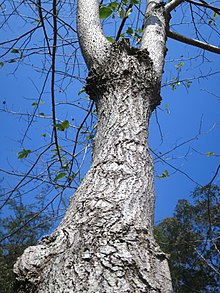Camptotheca: Difference between revisions
m clean up using AWB |
No edit summary Tags: Mobile edit Mobile web edit |
||
| Line 28: | Line 28: | ||
The bark and stems of ''C. acuminata'' contain the [[alkaloid]] [[camptothecin]].<ref name=Li>{{ cite journal | title = Antifungal Activity of Camptothecin, Trifolin, and Hyperoside Isolated from ''Camptotheca acuminata'' |author1=Li, S. |author2=Zhang, Z. |author3=Cain, A. |author4=Wang, B. |author5=Long, M. |author6=Taylor, J. | journal = Journal of Agricultural and Food Chemistry | year = 2005 | volume = 53 | issue = 1 | pages = 32–37 | doi = 10.1021/jf0484780 | pmid = 15631505 }}</ref> Several chemical [[derivative (chemistry)|derivatives]] of camptothecin are under investigation for or used as drugs for cancer treatment, including [[irinotecan]], [[topotecan]], [[rubitecan]].<ref>{{Cite book| author = G. Samuelsson| title = Drugs of Natural Origin: a Textbook of Pharmacognosy | year = 2004 | publisher = Swedish pharmaceutical press | location = Stokkholm | edition = 5| isbn = 91-974318-4-2 }}</ref> |
The bark and stems of ''C. acuminata'' contain the [[alkaloid]] [[camptothecin]].<ref name=Li>{{ cite journal | title = Antifungal Activity of Camptothecin, Trifolin, and Hyperoside Isolated from ''Camptotheca acuminata'' |author1=Li, S. |author2=Zhang, Z. |author3=Cain, A. |author4=Wang, B. |author5=Long, M. |author6=Taylor, J. | journal = Journal of Agricultural and Food Chemistry | year = 2005 | volume = 53 | issue = 1 | pages = 32–37 | doi = 10.1021/jf0484780 | pmid = 15631505 }}</ref> Several chemical [[derivative (chemistry)|derivatives]] of camptothecin are under investigation for or used as drugs for cancer treatment, including [[irinotecan]], [[topotecan]], [[rubitecan]].<ref>{{Cite book| author = G. Samuelsson| title = Drugs of Natural Origin: a Textbook of Pharmacognosy | year = 2004 | publisher = Swedish pharmaceutical press | location = Stokkholm | edition = 5| isbn = 91-974318-4-2 }}</ref> |
||
''C. acuminata'' also contains the chemical compounds [[trifolin]] and [[hyperoside]].<ref name=Li/> |
''C. acuminata'' also contains the chemical compounds [[trifolin]] and [[hyperoside]].<ref name=Li/> |
||
This awesome |
|||
== References == |
== References == |
||
Revision as of 20:21, 22 January 2017
| Happy tree | |
|---|---|

| |
| Camptotheca acuminata | |
| Scientific classification | |
| Kingdom: | |
| (unranked): | |
| (unranked): | |
| (unranked): | |
| Order: | |
| Family: | |
| Genus: | Camptotheca |
| Species | |
|
Camptotheca acuminata | |
Camptotheca (happy tree, cancer tree, or tree of life) is a genus of medium-sized deciduous trees growing to 20 metres (66 ft) tall, native to southern China and Tibet. The genus is usually included in the tupelo family Nyssaceae, but sometimes included (with the tupelos) in the dogwood family Cornaceae.
The name "happy tree" is a direct translation of the Chinese name xǐ shù (Simplified Chinese:喜树).
There are two species:
- Camptotheca acuminata Decne.
- Camptotheca lowreyana S.Y.Li
The bark and stems of C. acuminata contain the alkaloid camptothecin.[1] Several chemical derivatives of camptothecin are under investigation for or used as drugs for cancer treatment, including irinotecan, topotecan, rubitecan.[2]
C. acuminata also contains the chemical compounds trifolin and hyperoside.[1]
This awesome
References
- ^ a b Li, S.; Zhang, Z.; Cain, A.; Wang, B.; Long, M.; Taylor, J. (2005). "Antifungal Activity of Camptothecin, Trifolin, and Hyperoside Isolated from Camptotheca acuminata". Journal of Agricultural and Food Chemistry. 53 (1): 32–37. doi:10.1021/jf0484780. PMID 15631505.
- ^ G. Samuelsson (2004). Drugs of Natural Origin: a Textbook of Pharmacognosy (5 ed.). Stokkholm: Swedish pharmaceutical press. ISBN 91-974318-4-2.
